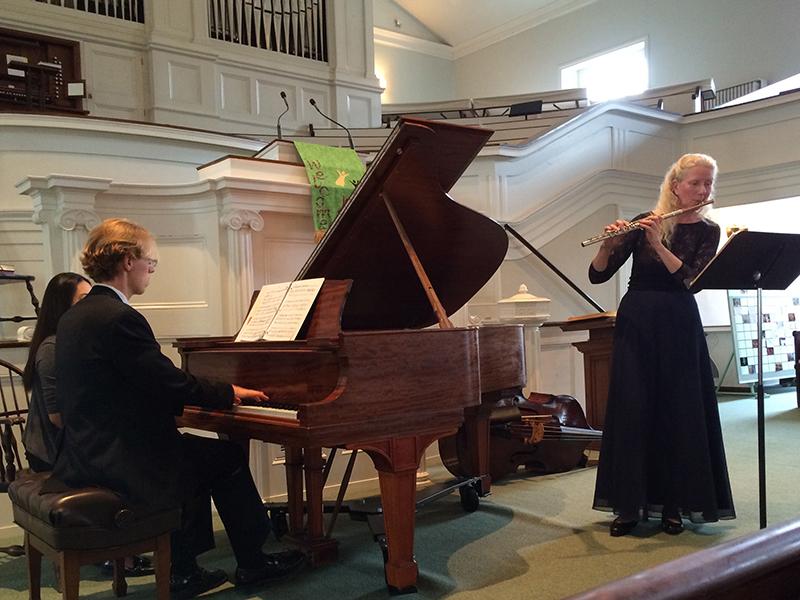Jazz, Classical Faculty Perform on Refurbished Piano
Alexa Still, associate professor of Flute, and pianist Thomas Bandy, musical coordinator of opera productions, perform Copland at the inaugural concert of the Music at the Meeting House series. Classical and Jazz faculty took the stage of First Church to unveil a newly refurbished 1911 Steinway on Saturday.
October 3, 2014
Conservatory faculty unveiled a newly refurbished Steinway piano to the public on Sunday afternoon for the inaugural concert of the Music at the Meeting House series. Members of the Oberlin community gathered in the historical First Church sanctuary to enjoy the incredible versatility of the program, which included everything from stately waltzes to operatic arias to jazz standards.
Sigrun Heinzelmann, associate professor of Music Theory, opened the concert with Maurice Ravel’s Valses nobles et sentimentales. Coincidentally, Ravel wrote the pieces in 1911, which is the same year that the featured Steinway was built. Before launching into her interpretation, Heinzelmann explained that the suite is composed of eight waltzes inspired by the work of Franz Schubert. Ravel’s piece includes dissonances meant to heighten the dramatic effect of the music. The 1911 debut of this work was performed anonymously, and most critics, not realizing whose music they were criticizing, gave the waltzes an extremely negative review. However, despite its initially rocky reception, the piece was orchestrated as the ballet Adélaïde, ou le langage des fleurs the following year.
Heinzelmann’s interpretation highlighted the evocative quality of the waltzes. From the first notes, the music called a traditional ballroom scene to mind through its graceful, steady melodies. The piece began with an energetic and powerful motif; Heinzelmann’s fingers danced across the keys with astounding agility, and her technique never once slipped. As the music frequency of notes diminished, the dissonances became increasingly pronounced, illustrating the awkward romance depicted in the ballet version. Heinzelmann’s potent dynamics gave power to the slower segments and enabled a gradual transition from spry and light to forceful and frantic and then back again. The final waltz was an epilogue into which the musical gestures from the former waltzes faded in and out; Heinzelmann characterized this conclusion as “dreamlike” in her introductory notes. Quiet, hesitant melodies alternated with assertive gestures, until at last the music wound to a finish, perfect silence enveloping the room upon the release of the final note.
Alexa Still, associate professor of Flute, and pianist Thomas Bandy, musical coordinator of opera productions, took the stage following Heinzelman’s compelling start to the concert. They performed Aaron Copland’s 1971 Duo for Flute and Piano, which was one of the last works Copland composed during his prolific career. Still described the first movement as “wide-open Americana with spare harmonies,” while the final movement, conversely, combines the rambunctious mood of a hoedown with Stravinskyan and modernist melodic influences. Throughout the piece, the piano acted as a stable base for the more active flute lines, which fluctuated between wild successions of shrill high notes and flowing waves of
melodies.
Maurice Ravel’s impressionism returned in the third work of the afternoon, “Don Quichotte à Dulcinée,” composed for a French film adaptation of the classic 17th-century novel Don Quixote. Timothy LeFebvre, associate professor of Singing, sang with a powerful voice that imbued every syllable with stirring emotion. The piece consisted of three distinct songs, “Chanson romanesque,” “Chanson épique” and “Chanson à boire” (translated respectively as “novelistic song,” “epic song,” and “drinking song”). The first was pleading, with lyrics that spoke of desperate love. LeFebvre conveyed the meaning of the French words clearly, though the program printed an English translation for those interested. The second song was a determined prayer, calling upon saints, angels and Mary to aid Don Quixote in his quest for a woman’s love. In the third and final song, Howsman brought a lighter, airier energy to the piano part that contrasted with the pointedly assertive vocal melodies. Operatic laughter from LeFebvre was met with appreciative laughter from the audience as he completed his portion of the program.
The concert concluded with two jazz standards performed by Peter Dominguez, professor of Jazz Studies and Double Bass, and Dan Wall, associate professor of Jazz Piano. Dominguez’s bass dates back to the 1790s, predating the refurbished piano by more than a century. They began with a rendition of “Soul Eyes” by Mal Waldron, a song that emobides the spirit of legendary bassist and photographer Milt Hinton, whose photography subjects, according to Dominguez, “were responding to [his] soul.” Hinton’s pictures are currently on display at the Allen Memorial Art Museum. The low growl of the bass and slow, cautious melodies evoked the loneliness of a solitary, late-night walk. The duo’s second piece, George Shearing’s “Conception,” was sprightly and light. The music contrasted the previous work with an abundance of rhythmic energy and closed the concert in a spirited gambol.
















